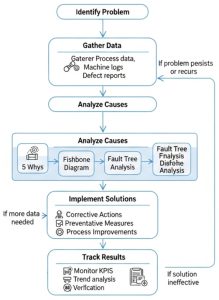The Engineering Change Order (ECO) process is an important aspect of modern manufacturing environments, significantly impacting both operational efficiency and cost management. In industries such as aerospace and defense manufacturing, automotive, and medical devices, understanding how to efficiently handle design changes prevents costly disruptions and spreads a culture of continuous improvement. This article will describe some of best practices associated with the ECO process, exploring its workflow, essential documentation components, and the role of the Change Control Board (CCB).
Successfully managing design changes requires a deep understanding of stakeholder communication and a well-documented strategy for root cause analysis, especially in industries where the cost of inefficiencies can be staggering. Differentiating between minor, major, and emergency changes is crucial for prioritizing resources and mitigating future disruptions.
Key Takeaways

- Follow structured ECO workflow for consistency.
- Document key details on the ECO form clearly.
- Involve CCB for informed change approvals.
- Conduct root cause analysis to reduce recurrence.
- Classify changes as minor, major, or emergency.
- Measure ECO performance with specific metrics.
The formal ECO Process Workflow in Manufacturing Environments

The formal Engineering Change Order (ECO) process workflow within manufacturing environments involves a structured series of steps to ensure changes are implemented smoothly.
Initially, change requests are submitted and reviewed by engineering teams, Quality and product owner or customer representative to assess their validity and necessity.
Research indicates that a well-defined ECO process can reduce change-related disruptions by up to 30%, allowing for efficient management of resources.
Following the initial review, the proposed changes are presented to the Change Control Board (CCB) for further evaluation. This group assesses the implications of changes by scrutinizing design impacts and cost factors. Decisions stemming from the CCB can lead to several outcomes, including approval, modifications, or rejection of the change, ensuring alignment with organizational goals.

After approval, detailed documentation and a communication plan are established to inform all stakeholders of the changes. This includes updates to relevant design documents and production processes. Timely implementation of these changes is essential, as it can greatly influence production timelines, potentially decreasing lead times by up to 25% if managed effectively.
Tip: implement a digital tracking system to monitor ECO status in real-time, enhancing visibility and accountability.
Essential Components of an ECO Form for Effective Documentation

An effective Engineering Change Order (ECO) form should contain several essential components to facilitate clear communication and documentation in manufacturing environments.
A well-structured ECO form typically includes as references the following attributes:
- a standardized title,
- unique identifier (ECO number),
- initiator or author
- and the date of submission.
These elements only serve as critical reference points for both tracking and retrieval throughout the design change process; they are not the content, the cause, nor the change itself.
Another key component is a detailed description of the proposed change: this section must articulate the reason behind the change while also identifying the affected items, such as parts, assemblies, or system designs. It enables stakeholders to understand the implications of the change, thus minimizing misunderstandings and potential disruption. Proper documentation here can reduce the average ECO processing time from weeks to just a few days in high-performing organizations.
Attachments such as sketches, specifications, or related documentation are also vital for process so as for later traceability. These visual aids assist engineering and production teams in comprehending complex modifications. An inclusive approach, where all relevant data is compiled in the ECO, enhances the overall quality of the review process and allows for efficient assessment by the Change Control Board.
Eventually some tests, validations or re-validation can be judged necessary.
Finally, an ECO form should feature an approval section: this is where designated authorities can formally accept or reject the proposed changes. Clearly defined roles and signatures ensure accountability and traceability.

The Role and Function of the Change Control Board

Operational effectiveness relies significantly on the CCB’s methodical review process. Each proposed ECO undergoes rigorous examination to assess its technical viability, cost impact, and alignment with overarching business objectives. Typically, this team includes engineers, quality assurance specialists, and project managers. Their diverse expertise contributes to well-informed decisions, thereby minimizing the risk of costly mistakes stemming from uninformed alterations.
Effective communication is integral to the CCB’s operations. Regularly scheduled meetings allow stakeholders to discuss pending modifications and their potential effects. By meticulously documenting decisions and their justifications, the CCB ensures traceability for any issues that may surface post-implementation. This level of transparency is particularly important in industries such as Aerospace and Defense, where compliance with regulations bears significant consequences.
In instances requiring immediate design alterations, the CCB may convene emergency meetings. These expedited sessions enable rapid decision-making, thereby reducing production delays. For instance, automotive manufacturers have utilized emergency CCBs to swiftly address component failures, preserving production timelines and maintaining customer satisfaction.
To assess the CCB’s performance, organizations should track metrics such as for example:
| CCB Metrics | Importance |
|---|---|
| Average Approval Time | Measures decision-making efficiency |
| Revisitation Rate | Indicates quality of initial decisions |
Tip: establish a clear documentation process during CCB meetings to ensure proper tracking of decisions and rationale, enhancing accountability and transparency
Strategies for Root Cause Analysis to Mitigate ECOs

Root cause analysis (RCA) serves as a fundamental process for reducing the occurrence of Engineering Change Orders (ECOs) within diverse manufacturing sectors. Structured methodologies, such as the “5 Whys” technique, enable teams to delve deeper into problems by continuously probing the reasons behind them. For instance, when examining a recurring defect in aerospace components, this approach can reveal that the root cause lies in insufficient material specifications.
The use of Fishbone Diagrams enhances brainstorming sessions, allowing cross-functional teams to collaboratively identify potential design failure causes. This visual...
You have read 43% of the article. The rest is for our community. Already a member? Log in
(and also to protect our original content from scraping bots)
Innovation.world community
Login or Register (100% free)
View the rest of this article and all members-only content and tools.
Only real engineers, manufacturers, designers, marketers professionals.
No bot, no hater, no spammer.
Frequently Asked Questions
What is the formal ECO process workflow in manufacturing environments?
The formal ECO process workflow typically includes initiation, analysis, review, and implementation and effectiveness control stages. Each stage ensures that changes are thoroughly evaluated and documented to minimize disruption and cost during production.
What are the essential components of an ECO form for effective documentation?
An ECO form should at minimum include part numbers, the reason for the change, a safety or risk analysis, and a cost impact analysis. Proper documentation ensures clarity and accountability throughout the change process.
What is the role and function of the Change Control Board in decision-making?
The Change Control Board (CCB) is responsible for reviewing and approving or rejecting proposed changes. This governance structure ensures that all aspects of the changes, including risk and resource allocation, are considered before implementation.
What strategies can be used for root cause analysis to mitigate future ECOs?
Effective root cause analysis strategies include techniques such as the 5 Whys, Fishbone diagrams, and Failure Mode and Effects Analysis (FMEA). These methods help identify underlying issues that lead to changes, allowing teams to implement corrective actions that prevent recurrence.
How can one differentiate between minor, major, and emergency changes in design?
Minor changes typically involve low human risk and minimal cost, while major changes may significantly affect design, customer or production schedules. Emergency changes are urgent and often require expedited approval due to safety or compliance issues.
What metrics should be used for tracking ECO efficiency and measuring success?
Key metrics for tracking ECO efficiency include cycle time from initiation to implementation and the associated costs of changes. These metrics provide insight into the effectiveness of the ECO process and opportunities for improvement.
How does the ECO process vary in different manufacturing sectors like Aerospace and Defense, Automotive, and Medical devices?
The ECO process may vary based on industry regulations, compliance standards, and the complexity of products. For example, although all require safety as a main principle, Aerospace and Defense may require more rigorous validation steps compared to the Automotive sector, which focuses on cost-effectiveness due to high volumes and untrained non-pro users.
What challenges are commonly faced in implementing an effective ECO process?
Challenges in implementing an effective ECO process include resistance to change, lack of clear communication, and insufficient resource allocation for evaluation. Addressing these issues early can enhance the likelihood of a successful implementation.
Related Topics
- Change Impact Assessment: analyzing potential effects of an engineering change on the overall project and production.
- Design Verification and Validation: procedures to ensure that changed designs meet specified requirements and intended use.
- Version Control Systems: software solutions for tracking changes in design documents throughout the ECO lifecycle.
- Supplier Communication Plan: strategies for ensuring suppliers are informed and involved in the ECO process to maintain alignment and quality.
- Change Order Database: a central repository to archive all ECOs for future reference and analysis.
- Compliance and Regulatory Considerations: understanding and integrating relevant regulations into the ECO process, especially in industries like medical devices.
- Sustainability Impacts of Changes: assessing how design changes align with environmental and sustainability goals within the manufacturing process.
- Post-Implementation Review: evaluating the outcomes of an ECO after implementation to identify lessons learned and improvement opportunities.
- Technical Documentation Updates: ensuring all related documentation is revised to reflect changes made in the ECO process.
- Budget Implications of ECOs: assessing financial impacts related to engineering changes, including potential savings and expenditures.
External Links on Engineering Change Order (ECO)
International Standards
(hover the link to see our description of the content)












Related Posts
Use or Abuse 25 Cognitive Biases in Product Design and Manufacturing
Revised NIOSH Lifting Equation in Bench Ergonomics
Dark Web vs Darknet vs Deep Web: 101 & More
Latest Publications & Patents on Cellular Automata
Darknet Tools For Engineering And Science
101 on How to Best Read a Patent (for a non Patent Attorney)